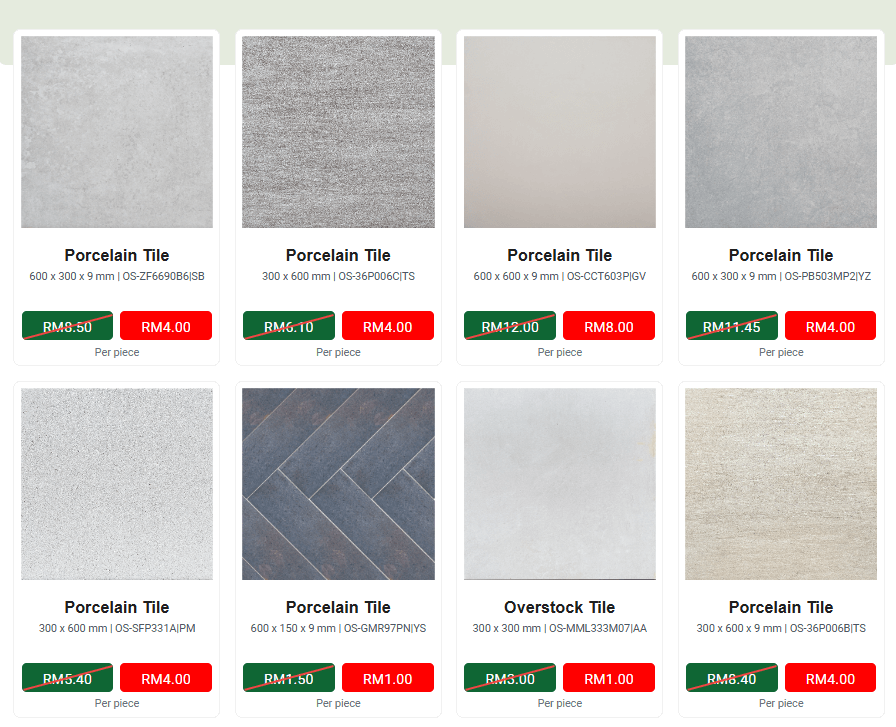Purchasing tiles for your home renovation can feel overwhelming—especially if you’re a first-time homeowner. You might be asking: How many tiles do I really need? Which types are best suited for each area of my home? Who are the most reliable suppliers, and how should I plan my renovation budget?
Although these questions can seem daunting at first, this guide will walk you through the process step by step, providing you with practical tips and expert insights tailored for the Malaysian market.
Let’s dive in.
Types of Tiles in Malaysia
When planning your renovation, it’s important to understand the wide variety of tiles available in the Malaysian market. Each type offers unique benefits and aesthetic qualities. Below is an overview of the most common tile types many Malaysian homeowners opt for:
- Subway Tiles
- Ceramic Tiles
- Porcelain Tiles
- Terracotta Tiles
- Moroccan Tiles
In addition to these traditional options, some modern designs even explore sustainable materials such as composite bamboo for a unique and eco-friendly finish.
These options provide a good starting point for exploring what suits your design and functional needs.

Differences Between Floor Tiles and Wall Tiles
There are no hard-and-fast rules when distinguishing between floor and wall tiles—the decision ultimately depends on factors like durability, slip resistance, and design preference.
For instance, porcelain tiles are typically favored for floors due to their strength and durability. That said, ceramic tiles might also work well, particularly if budget constraints or stylistic choices come into play.
For a modern twist, consider accentuating your interior design with glass mosaic tiles on a feature wall or as subtle detailing.
In spaces where natural light is limited or the room is narrow—such as a corridor—using elongated tiles can create an illusion of expanded space.
Expert Tip from HOMA2u:
For high-traffic areas such as floors, opt for tiles known for their strength and longevity. This not only ensures cost efficiency in the long run but also minimizes maintenance. For decorative purposes on walls or accent areas, tiles like subway or Moroccan styles can add flair—though they may come at a premium.
Before You Start Buying Tiles
Before you rush out to purchase tiles or contact suppliers, there are several key steps to take:
1. Understand Your Home’s Dimensions and Layout
It may seem obvious, but knowing your home’s size and layout is crucial. Walk through your space or get professional measurements to understand the dimensions of each room. This information will help you calculate the number of tiles needed and guide your overall design choices.
2. Define Your “Wow Factor”
Decide on the standout elements you want in your home. Whether it’s a futuristic wardrobe design inspired by a movie, a kitchen accented with bold black subway tiles, or a striking feature wall with unique ventilation blocks, pinpointing your “wow factor” early on will help shape your design.
Pro Tip: Create a list or mood board by browsing home design magazines or joining local home improvement groups on social media.
3. Consult a Contractor or Interior Designer
Even if you’re a DIY enthusiast, consulting a professional can save you time, reduce mistakes, and enhance the final result. An interior designer or contractor can assist with everything from planning and design to execution and supplier negotiations. Their expertise is invaluable in ensuring your renovation is both beautiful and functional.
Before proceeding, don’t forget to measure any outdoor spaces as well. If you have a spacious terrace, selecting tiles that are weather-resistant can help extend your design beyond the indoors.
Calculating the Number of Tiles You Need
If you’re planning to tackle some of the planning yourself, here’s a straightforward way to estimate how many tiles you’ll need:
- Measure Your Space:
- For a room, calculate the area by multiplying its length by its width.
- For walls, measure the length of the wall and the height if applicable.
- Determine Tile Coverage:
- Divide the total area by the coverage area of one tile (or one box of tiles).
Example:
Imagine your master bedroom measures 3.5m x 4m, totaling 14 square meters. If you choose Guocera tiles that cover 1.44 square meters per box, divide 14 by 1.44 to arrive at roughly 9.7 boxes. Rounding up, you’d initially need 10 boxes—but to account for wastage and any accidental breakages during installation, it’s wise to purchase at least one extra box, making it 11 in total.
Remember: This calculation provides a baseline estimate; adjustments may be needed based on the room’s shape and layout.

Common Mistakes to Avoid When Purchasing Tiles
Avoiding these pitfalls can save you time, money, and stress during your renovation:
1. Insufficient Tiles
Underestimating the number of tiles needed is a common error. Aside from installation waste, consider that future repairs may require matching tiles. Running out can force you to pay a premium for new stock—or worse, settle for an imperfect match.
2. Choosing the Wrong Tile Size
Tiles come in a variety of sizes, and not all suppliers offer every option. If your room isn’t a standard square or rectangle, calculating the exact number of tiles becomes more complex. In such cases, consult a professional to help determine the appropriate size and quantity.
3. Mismatched Applications
Using decorative tiles in areas that require durability can be a recipe for disaster. For example, applying subway tiles on a high-traffic floor may compromise safety if they lack proper slip resistance. Always verify with your supplier whether a tile is suitable for its intended use—be it for floors, walls, or accent features.
4. Overlooking Delivery Costs
It’s easy to forget that delivery fees can significantly impact your renovation budget. Make sure to include these additional costs when planning your project, especially if you’re ordering a large volume of tiles.
Choosing the Right Tile Supplier in Malaysia
After you’ve navigated the selection process and planned your project, the final step is to choose a supplier who meets your needs and can deliver your tiles on time.
At HOMA2u, we take pride in offering not only a wide range of high-quality tiles but also the expert guidance and reliable service you need for a successful renovation.
With careful planning, a clear vision, and the right professional support, buying tiles can be an enjoyable and rewarding part of your home transformation journey.
By taking the time to understand your space, define your style, and plan meticulously, you’ll be well on your way to a renovation that truly reflects your vision and stands the test of time. Happy renovating!

